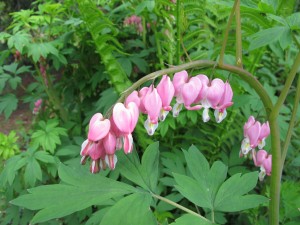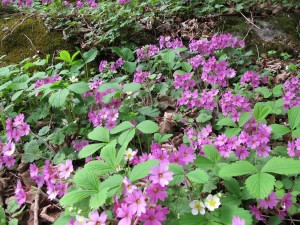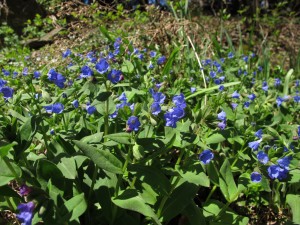Spring Flowers
Like most gardeners, I rejoice in spring. New leaves on trees have a special hue; the grass is finally green; flowers of every persuasion are in bloom. The air is warm, the black flies haven’t arrived, life is good. So we trundle off to the garden center and buy flowers and plant them. Here are some flowers I am enjoying in May, including a few you might not have in your garden.
I know most of you don’t like Latin names of flowers, but they are useful for precisely naming flowers, and for showing relationships. The scientific genus Dicentra is in its full glory now: D. spectabalis, D. exemia, D. cucularia are three species in bloom for me.
The first one (D. spectabalis ) is spectacular, as its Latin name indicates. I have some plants that stand up to 3 feet tall and wide, and it can have dozens of flower stems at once. You probably call it bleeding heart – though some call it “a living Valentine”, which is appropriate since the strands of pink flowers are shaped like cut-out hearts with little appendages hanging down, perhaps drops of blood from a broken heart. It also comes in a pure white variety, a sub-species with the epithet ‘alba’ appended to its name.
Bleeding hearts will grow in full sun, but do better in part sun or dappled shade and rich, lightly moist soil. Full afternoon sun will make them run through the bloom cycle more quickly and the foliage to turn yellow well before autumn.
Fringed bleeding heart (D. exemia) is shorter and less showy. It is a shade plant that will bloom on and off all summer, which is unusual for a perennial. The flowers come in shades of pink to reddish, and there is also a white variety. Although it is often called wild bleeding heart, I have only seen it in the woods a few times. Its foliage is very nice – it is highly incised and frilly.
The last of the three, D. cucularia, is commonly known as Dutchman’s breeches for the white flowers which resemble pants hanging on a clothesline. It is a true wildflower, but is sold at a few good nurseries. It is what is called a spring ephemeral: it comes up, blooms, and the foliage disappears after a few weeks. I pronounce its species name cuckoo-laria, which to me is a humorous name for a flower. “Cuckoo, cuckoo” I call out to it when I see it blooming. (See, aren’t you liking Latin better? It can be fun to use.) Mine grows in the shade of an old apple tree in damp, rich black soil.
If you have a mature apple tree, it is a great place for growing primroses. In mid-May I have several species growing under mine, including a fabulous magenta-colored one that has no common name, so you will have to ask for it by its Latin name, Primula kisoana. Or you can call it the kissing primrose, I suppose, since the species name starts off with “kiss”. (Kiss-o-ana). But at the garden center they will not know it by that name, only the Latin. I got mine at Cider Hill Gardens in Windsor, VT.
Primroses are low plants that grow in clumps that I have in all colors except blue. Most do best in shade or part shade, and many will grow in dry shade – though moist soil is better for most. Coming along soon I will have the candelabra primroses (Primula japonica), which indicates they were introduced from Japan). These are the tallest of my primroses, reaching up to 18 inches or so. They have three tiers of blossoms sticking out off a tall straight stem sort of like the spokes of a wagon wheel, and come in at least 3 colors – white, pink, deep red.
For the past 6 weeks or more I’ve had various colors of lungwort (Pulmonaria longifolia) blooming. Lungwort is a dreadful name for a lovely flower, so I call it by its Latin genus, Pulmonaria (pronounced Pull-mon-aria) . It starts very early and blooms for a long time; it comes in a variety of colors: blue, peach, pink and combinations of those. It spreads by root, filling in dark, shady places that many flowers would eschew. It does fine in crummy dry soil.
You know the common bulb plants: daffodils, tulips, crocus. If you’ve planned well – selecting early, mid- and late-season varieties – you have examples of those blooming much of the spring. But do you have summer (or giant) snowflake (Leucojum aestivum)? It is wonderful! I’ve had a clump for 15 years or more, and it just gets bigger and better every year. It reminds me of snowdrops on steroids. White nodding blossoms on tall green stems and lots of foliage. Mine are 18-24 inches tall, even though my reference text on bulbs (Taylor’s Guide to Bulbs) says it should be only 9-12 inches tall.
One last thought: take pictures of your flowers on a weekly basis. These will help you do planning next winter when you are trying to see what times of the year need more color. Your digital camera will keep track of the dates of blooming, too.
Henry Homeyer is a garden designer and public speaker on gardening. Contact him at henry.homeyer@comcast.net, PO Box 364 , Cornish Flat, NH 03746 or 603-543-1307.





